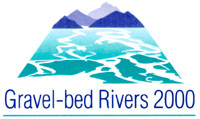|
|
|

|
|
|
|

|
Keywords: braided rivers; scanning airborne
laser; time-lapse video; gravel sheets; dendritic channel networks; alternate
bars.
Introduction
Braided rivers have to date been described and classified in terms of their two-dimensional planform appearance, as presented by the pattern formed by their wetted channels. Some definitions of braiding simply require anabranches that divide and join, while others (e.g., Ashmore, 1991) distinguish braiding channels, which actively maintain an ever-changing but statistically similar pattern, from anastomosing channel networks, which branch and join around islands but show temporal stability.
Various studies (e.g., Leopold and Wolman, 1957, Henderson, 1961) have shown that braided rivers tend to occur within a particular 'existence space' defined by limited ranges of water discharge (Q), valley slope (S), bed material size (D), and bank strength. Typically, braided channels occur with abundant supplies of non-cohesive bed material, adequate stream power (proportional to QS) to transport the bed material, low-strength non-cohesive bed and bank material, and a geomorphic setting that provides for sufficient lateral space for the braiding pattern to develop. A key factor is the ready availability of recyclable bed material from braid banks. Factors which increase bank strength, such as cohesive sediments and vegetation, thwart this process, and the river flow tends to concentrate in a single channel which either meanders or, with a steeper valley slope, forms a straight, alternate-bar type channel.
The emphasis on such classification systems of channel pattern has generally been to explain why channel patterns vary spatially, from river to river or from reach to reach. In this paper, we take a new view of a braided riverbed, based not on the pattern of wetted channels but on the full three-dimensional topography of the entire riverbed. By doing this we discover a pattern of channels that is more complex than that suggested from aerial photographs but nonetheless may be explained in terms of a superposition of morphologic features of different scales that are formed at different levels of flood flow. We do this by examining, at high spatial density and resolution, the topography of a braided reach of the lower Waimakariri River near Christchurch, New Zealand. Also, we monitor the evolution of morphologic features using time-lapse video imagery from cameras that provide an oblique aerial view of the riverbed.